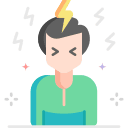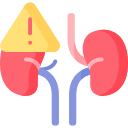Marketer: Consern Pharma Ltd
(Bold for FDA approved)
 How Antichol works
How Antichol works• Diminishes the excess acetylcholine activity caused by removal of dopamine inhibition when dopamine receptors are blocked
• May also inhibit the reuptake and storage of dopamine at central dopamine receptors, prolonging dopamine action
• For drug-induced parkinsonism and in Parkinson’s disease, onset of action can be within minutes or hours
 Notable Side Effects
Notable Side Effects• Dry mouth, blurred vision, diplopia
• Confusion, hallucinations
• Constipation, nausea, vomiting
• Dilation of colon
• Erectile dysfunction
 Life Threatening Side Effects
Life Threatening Side Effects• Angle-closure glaucoma
• Heat stroke, especially in elderly patients
• Tachycardia, cardiac arrhythmias, hypotension
• Urinary retention
• Anticholinergic agents such as trihexyphenidyl can exacerbate or unmask tardive dyskinesia

unusual

common
• For confusion or hallucinations, discontinue use
• For sedation, lower the dose and/or take the entire dose at night
• For dry mouth, chew gum or drink water
• For urinary retention, obtain a urological evaluation; may need to discontinue use
• Drug-induced parkinsonism: 5–15 mg/day
• Parkinsonism: 6–15 mg/day
 Dosage Forms
Dosage Forms• Tablet 2 mg, 5 mg
• Injection 2 mg/5 mL
• Safe
• Effectiveness may decrease over time (years) and side effects such as sedation and cognitive impairment may worsen
• No
 Renal Impairment
Renal Impairment• No known effects, but use with caution
 Hepatic Impairment
Hepatic Impairment• No known effects, but use with caution
 Cardiac Impairment
Cardiac Impairment• Use with caution in patients with known arrhythmias, especially tachycardia
 Elderly
Elderly• Use with caution
• Elderly patients may be more susceptible to side effects
 Children and Adolescents
Children and Adolescents• Do not use in children ages 3 and younger
• Generalized dystonias may respond to anticholinergic treatment, and young patients usually tolerate the medication better than the elderly
• Usual dose is 0.05 mg/kg once or twice daily
 Pregnancy
Pregnancy• Effective June 30, 2015, the FDA requires changes to the content and format of pregnancy and lactation information in prescription drug labels, including the elimination of the pregnancy letter categories; the Pregnancy and Lactation Labeling Rule (PLLR or final rule) applies only to prescription drugs and will be phased in gradually for drugs approved on or after June 30, 2001
• Controlled studies have not been conducted in pregnant women
 Breast Feeding
Breast Feeding• Unknown if trihexyphenidyl is secreted in human breast milk, but all psychotropics are assumed to be secreted in breast milk
• Recommended either to discontinue drug or bottle feed unless the potential benefit to the mother justifies the potential risk to the child
• Infants of women who choose to breast feed while on trihexyphenidyl should be monitored for possible adverse effects
Based on data Published online by Cambridge University Press
Compiled by Dr. Jash Ajmera